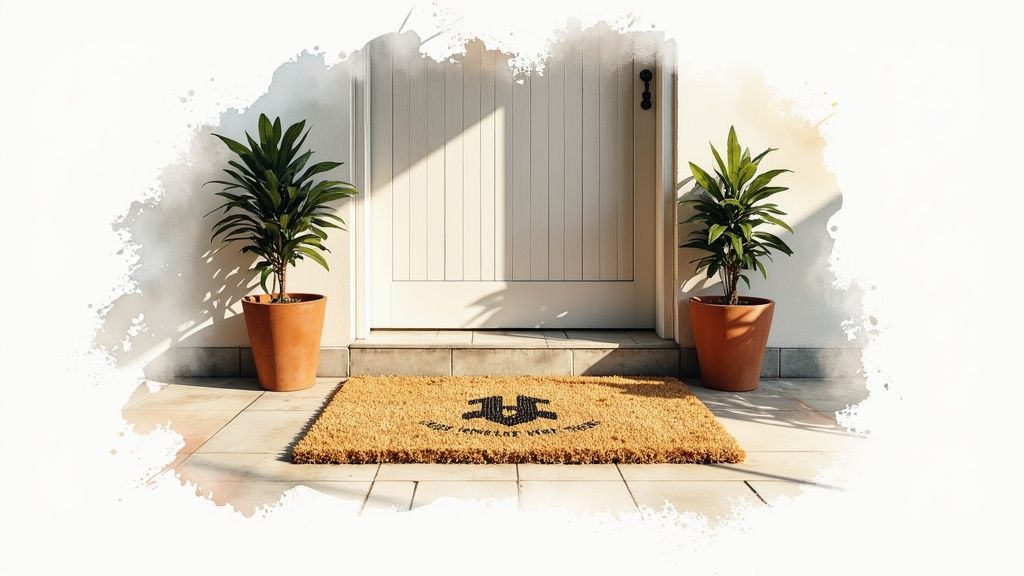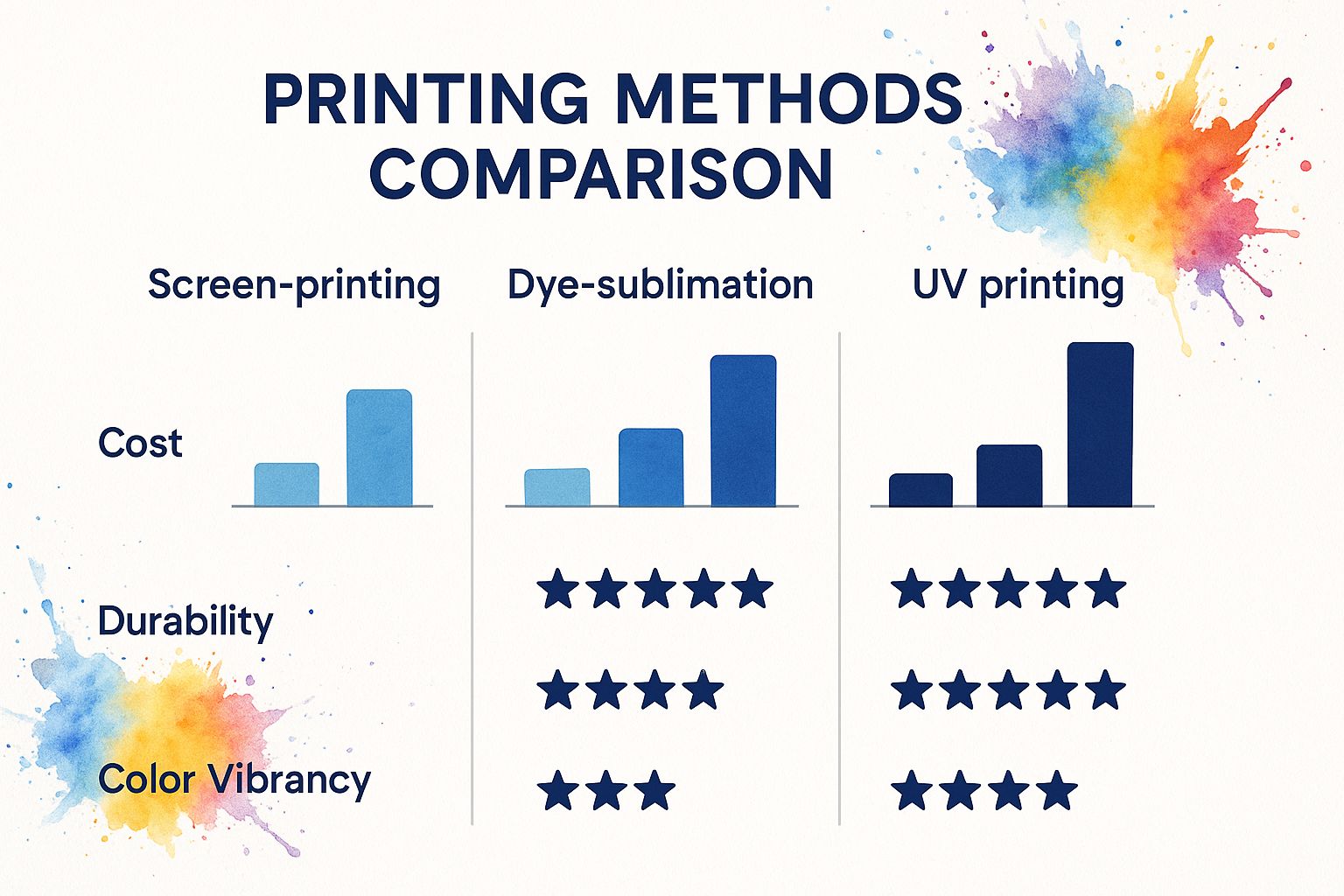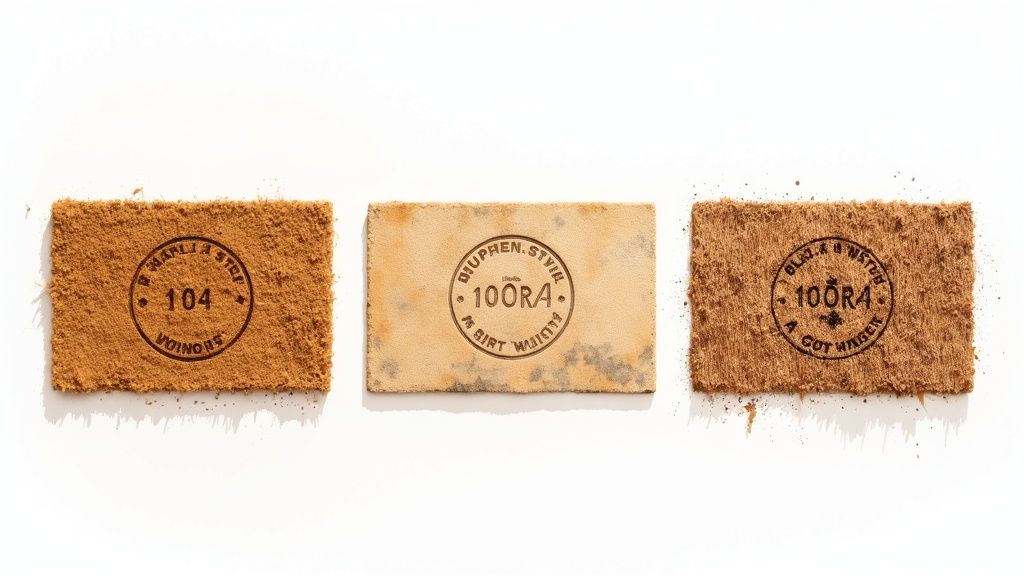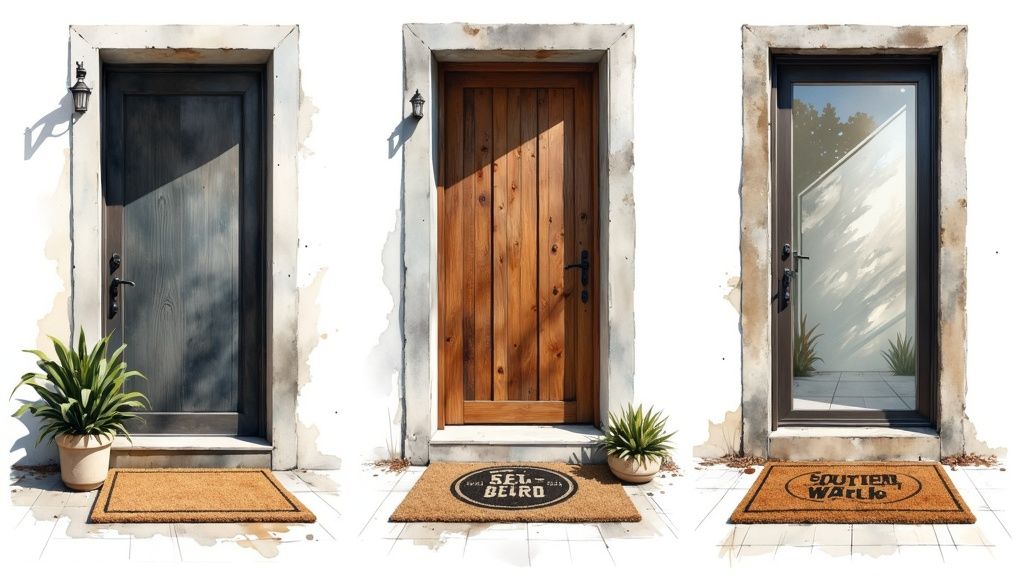A custom logo door mat is a surprisingly powerful tool that transforms a simple entrance into a professional brand statement. The concept is straightforward: combine the practical, floor-protecting function of a doormat with the visual impact of your brand. The benefit to you? A professional first impression for every visitor before they even walk through the door, reinforcing your brand's quality and attention to detail.
Why a Custom Logo Mat Is Your Silent Brand Ambassador
Think of your logo mat as the very first handshake your business offers. It's far more than just a place for people to wipe their feet; it’s a strategic asset that works for you 24/7. This simple addition immediately sets a professional tone, telling customers that you value quality and care about the details.
The dual benefit is what makes this such a smart, practical investment. First, it’s a branding powerhouse. Second, it's a functional workhorse. By actively trapping dirt, debris, and moisture at the door, it directly protects your interior floors. The immediate benefits for your business include:
- Reduced Cleaning Costs: Less dirt tracked inside means less time and money spent on daily cleaning.
- Enhanced Safety: Dry floors are safer floors, significantly reducing the risk of slips and falls.
- Improved Brand Recognition: It reinforces your brand identity at a key customer touchpoint.
How to Make an Immediate Brand Statement
Your logo mat is often the first and last physical touchpoint a person has with your business. The design you choose sends an instant message.
- Real-World Example: A high-end spa can use an elegant, minimalist door mats logo on a plush, dark gray mat to instantly communicate tranquility and luxury. In contrast, a busy industrial workshop might use a bold, high-visibility logo on a heavy-duty rubber mat to reinforce its focus on safety and durability.
This quick visual cue is a simple yet effective way to reinforce your brand identity. To learn more about the strategic benefits, see our article on the importance of a logo mat.
A Growing Trend in All Kinds of Spaces
It's not just us—businesses are catching on. The demand for entrance solutions that are both functional and visually appealing is on the rise.
The global door mat market, currently valued at around USD 8.21 billion, is projected to grow, driven by new construction and a greater focus on aesthetics and hygiene. Within this market, custom logo designs have become a popular strategy for businesses that want to maximize the utility of their entrance. You can read more about the global door mat market on globalgrowthinsights.com.
Key Takeaway: A door mats logo isn't a decorative expense. It's a functional tool that boosts safety, reduces maintenance costs, and works tirelessly to reinforce your brand's presence and values from the ground up.
Translating Your Brand Identity Into a Mat Design

A fantastic logo on your website doesn't automatically translate to a great floor mat. The key is to adapt your design for the unique texture and viewing angle of a mat. A successful door mats logo is one that’s instantly clear, readable, and impactful from a distance.
Remember, your visitors will be looking down, often while moving. Intricate details, subtle gradients, and delicate lines that look sharp on a screen can become lost or muddled in the mat's fibers.
How to Simplify for Maximum Impact
The first step is to identify the core, most recognizable elements of your logo.
- Actionable Step: Look at your logo and ask, "What is the one thing people remember?" If you're a restaurant with a detailed family crest, that might mean using just a single key symbol or the wordmark, rather than trying to fit the entire complex design onto the mat. A streamlined version often has more visual power.
- Real-World Example: A local coffee shop had a logo with a beautiful, elaborate illustration of a coffee bean featuring fine lines and shading. For their entrance mat, they wisely chose to use only the bold, stylized shop name from their logo. The result was a powerful, clear brand statement that every customer noticed upon entering.
How to Choose Colors and Fonts Wisely
Color and font choices are critical for readability on a mat. High contrast is your best friend. A dark logo on a light background (or vice versa) will always be more effective than low-contrast combinations that blend together.
Also, consider the colors of your physical space. The mat should complement your interior design, not clash with it. For more design tips, see our detailed guide on the topic.
Font legibility is equally crucial. Choose bold, clean fonts over thin, script-style ones that can be difficult to read from a standing height.
Actionable Takeaway: Before committing to a design, perform this simple test. Print your proposed logo on a piece of A4 paper, place it on the floor, and step back about 10 feet. Can you instantly identify the brand and read any text? If not, it's time to simplify further. This quick check prevents you from ordering a mat that fails to make the strong impression you want.
How to Choose the Right Mat Material for Your Environment
Picking the right material for your custom door mats logo is the most important practical decision you’ll make. The material determines the mat's durability, how sharp your logo looks, and how effectively it keeps your premises clean and safe. The secret is to match the material to your specific environment and foot traffic.
- Real-World Example (High Traffic): A busy retail shop that sees heavy foot traffic and exposure to rain and snow needs a workhorse. For this scenario, a rubber-backed nylon mat is the ideal solution. Its tough fibers excel at scraping mud and absorbing water, while the heavy rubber backing prevents it from slipping. The dense nylon pile also provides a perfect canvas for a crisp, detailed logo that withstands constant use.
- Real-World Example (Professional Setting): For a sleek corporate office lobby with steady but clean foot traffic, a plush polypropylene mat adds a touch of luxury. While less aggressive at scraping, it offers incredible colorfastness, ensuring your logo resists fading even in sunny entryways, directly benefiting your brand's professional image.
Getting to Grips With Different Materials
To make the best decision for your business, understand the pros and cons of common options.
- Nylon: The top choice for high-traffic commercial spaces. It’s incredibly resilient (fibers spring back after being compressed) and absorbs significant moisture. It’s also the best surface for high-definition, photo-realistic logo printing.
- Polypropylene: A great all-rounder. This synthetic fiber is highly resistant to stains, mildew, and fading, making it a solid, budget-friendly option for indoor or covered outdoor areas.
- Coir (Coconut Fiber): Best for scraping thick mud and heavy debris. It has a natural, rustic look. However, its coarse fibers are not suitable for intricate logos and it can shed over time.
- Nitrile Rubber: Often used for the entire mat, not just the backing. It's virtually indestructible, slip-resistant, and withstands grease and oils, making it perfect for industrial settings or commercial kitchens.
For a deeper dive into these options, check out our guide on choosing the right floor mat for your needs.
The infographic below breaks down how different printing methods—often tied to specific materials—compare in cost, longevity, and quality.

As you can see, while a basic screen-print might save you money upfront, methods like dye-sublimation or UV printing deliver far better durability and color vibrancy for a logo that truly pops and lasts.
Comparing Materials for Your Logo Door Mat
To help you choose the best fit, here’s a quick comparison of the most popular materials. Consider your daily foot traffic and mat placement as you review this table.
| Material Type | Best For | Durability | Logo Print Quality | Maintenance Level |
|---|---|---|---|---|
| Nylon | High-traffic entrances, commercial lobbies, retail | Very High | Excellent (HD) | Moderate |
| Polypropylene | Medium-traffic indoor or covered outdoor areas | High | Very Good | Low |
| Coir (Coconut) | Heavy-duty outdoor scraping, rustic aesthetic | Medium | Fair (Simple Logos) | Moderate |
| Nitrile Rubber | Industrial, kitchens, oily/greasy environments | Very High | Good | Low |
Ultimately, selecting the right material is about balancing your branding goals with the practical demands of your location. A well-chosen mat not only looks professional but also works hard to keep your space safe and clean for years to come.
How to Get Your Artwork and Proof Spot-On

You've planned your design and chosen your material. Now comes the critical technical step: turning that idea into a physical mat that looks exactly as you envisioned. Getting the artwork and proofing details right is the difference between a stunning success and a costly mistake.
The process begins when you submit your artwork file. The quality of the file you send directly determines the quality of the finished mat. While it’s tempting to send a standard JPG or PNG, these "raster" files are made of pixels and can become blurry and jagged when enlarged to mat size, resulting in an unprofessional finish.
Give Your Artwork the Best Chance to Shine
For a razor-sharp logo that looks crisp at any size, you must provide it in a vector format. These files, typically ending in .AI (Adobe Illustrator), .EPS, or .SVG, use mathematical equations instead of pixels. This means they can be scaled up to fit a large mat without losing any quality.
Color accuracy is the other key piece. The specific shade of blue on your screen can look different when printed on mat fibers. To ensure brand consistency, use the Pantone Matching System (PMS).
- Real-World Example: Imagine a national retail chain known for its distinctive red logo. They cannot afford brand inconsistency between locations. By providing their specific PMS code (e.g., PANTONE 186 C), they guarantee every single mat is the exact same vibrant, recognizable red, protecting their brand identity nationwide.
Don't Just Glance at Your Digital Proof
Before production, your supplier will send a digital proof. This is your final chance to catch errors. Do not just give it a quick glance—scrutinize every detail.
Actionable Takeaway: When the proof arrives, immediately perform this three-point check:
- Dimensions & Placement: Is the overall mat size correct? Is the logo positioned exactly where you want it?
- Color Codes: Do the colors listed on the proof match your brand’s specific PMS codes?
- Clarity & Spelling: Is the logo sharp? Is all text legible and spelled correctly?
Approving a proof with a mistake means you are accepting that mistake on the final product. A few minutes of careful review here will guarantee your door mats logo perfectly represents your brand.
How to Keep Your Logo Mat Looking Professional

A crisp, vibrant logo mat sends a powerful message of professionalism. Conversely, a grimy, faded mat can actively harm the image you've built. Protecting your investment requires simple, consistent care tailored to the material.
You wouldn't use the same cleaning method for carpet and rubber, and the same logic applies to your door mats logo.
- Real-World Example (Nylon Mat): A high-performance nylon mat in an office lobby benefits from regular, deep vacuuming. This lifts abrasive grit from the fibers, preventing them from being worn down and keeping your logo's colors vibrant.
- Real-World Example (Rubber Mat): A heavy-duty rubber mat outside an industrial facility is built to be hosed down. This quickly blasts away thick mud and grime, making it ideal for rugged environments where efficiency is key.
Smart Cleaning for a Lasting Impression
Proper care involves more than a quick sweep. It means knowing how to tackle stains and allowing the mat to dry properly to prevent mildew and damage. Getting these two steps right will dramatically extend your mat's life and keep your logo looking sharp.
For a complete guide, read our article on mastering floor mat cleaning for your business.
Quick Tip: To remove a stubborn stain on most synthetic mats, act fast. Blot the spot immediately with a clean cloth (don't rub it in). Then, use a mild detergent mixed with water and a soft brush to gently work on the area before rinsing thoroughly with clean water.
Here are actionable dos and don'ts for mat care:
- DO vacuum regularly to prevent abrasive dirt from being ground into the fibers.
- DO check the manufacturer’s cleaning instructions before using any chemicals.
- DO ensure the mat is 100% dry before placing it back down to prevent mold.
- DON'T use chlorine bleach, as it can permanently discolor your logo.
- DON'T fold or crush your mat for storage, as this can create permanent creases.
Your Custom Logo Mat Questions, Answered
Ordering a custom door mats logo is a great move for your brand, but it's smart to have all the facts first. Here are practical answers to the most common questions we hear from business owners.
How Much Should I Expect to Budget for a Custom Logo Mat?
The price can range from under $100 for a small, simple indoor mat to over $500 for a large, heavy-duty outdoor mat. The cost depends directly on three factors: size, material, and the complexity of your logo's colors. A large nitrile rubber mat with a high-definition, multi-color logo will be a bigger investment, but for a high-traffic entrance, it pays for itself in durability and brand impact. The best first step is to get a detailed quote based on your exact specifications.
How Long Will My Logo Mat Actually Last?
This depends entirely on the material and foot traffic. A high-quality nylon or rubber mat in a busy retail entrance can easily last 3-5 years with proper care. These materials are engineered to withstand heavy use while keeping your logo visible. In contrast, a natural coir mat in the same high-traffic spot may only last a year or two. For a low-traffic area like an office waiting room, you can expect any mat to look great for much longer. Always check the manufacturer's warranty, as it's a good indicator of expected lifespan.
Are There Any Limits on My Logo Design?
Yes, there are practical limitations. What looks good on screen may not translate perfectly to a textured, fibrous surface. The most effective door mats logo designs use bold lines and strong, contrasting colors that are easily visible from a distance. Very fine text, subtle color gradients, or highly intricate details can get lost in the mat fibers, diminishing their impact.
- Real-World Example: A law firm had a logo with a detailed crest and a thin, elegant font. For their mat, we advised a simplification. They opted to use just the firm's initials in a clean, bold font. The result was a much stronger, more legible design that looked professional and impactful from the entrance. It's always a good idea to consult with your supplier to ensure your design is optimized for your chosen material.
Ready to make that first impression count with a custom logo mat that truly stands out? Take a look through our collection at Mats4U. Our team is here to help you design the perfect welcome for your business.







